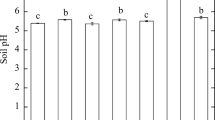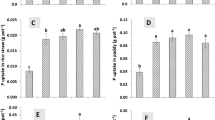Abstract
Cadmium (Cd) contaminated in rice grains is a serious problem because most Asians consume rice on a daily basis. Rice grown in Cd-contaminated soil normally did not have high concentration of Cd. However, soil samples used in this study had high concentrations of Cd. The purpose of this study was to clearly see the effects of biochar and microorganism addition in rice growing in Cd-contaminated soil. The initial Cd concentration in Cd-contaminated soil used in this study was about 650 mg kg−1. Cadmium concentration in rice plants grown in Cd-contaminated soil with the addition of 1 % (w/w) different biochars such as sawdust fly ash (SDFA), bagasse fly ash (BGFA), and rice husk ash (RHA) was investigated. The results showed that SDFA was the best biochar in terms of reducing cadmium accumulation in rice grains when compared to BGFA and RHA under the same conditions. In addition, rice plants grown in Cd-contaminated soil with the addition of various nonpathogenic microorganisms, such as Pseudomonas aeruginosa, Bacillus subtilis, and Beauveria bassiana were also studied. The results showed that the addition of 2 % (v/v) microorganisms can reduce Cd accumulation in grains. It was found that grains obtained from Cd-contaminated soil with the addition of P. aeruginosa had the lowest cadmium concentration compared to the ones from soil amended with other strains. This was due to the fact that P. aeruginosa adsorbed more Cd itself into its cells than other strains. The rice plants grown in Cd-contaminated soil with the addition of biochars and microorganisms were also compared. The results showed that adding 2 % (v/v) microorganisms seemed to reduce Cd accumulation in rice grains better than adding 1 % (w/w) biochars. In addition, the amounts of calcium and magnesium in rice grains and the dry weight of plant in Cd-contaminated soil amended with P. aeruginosa were the highest in comparison to other microorganisms, biochars, and the soil without any amendments (Cd-soil control). It might be possible that microorganisms can cause leaching of Ca, Mg, etc. from contaminated soil and compete with Cd to be uptaken by plants. This would cause the increase in plant dry weight and higher mineral nutrients accumulation in grains. Both biochars and microorganisms are suitable for reducing the amount of Cd in rice grains. The application should depend on farmers, biochars available in nearby areas, etc. Therefore, microorganisms and biochars can be used to solve the problem of cadmium contamination in rice grains.








Similar content being viewed by others
References
Al-Anber ZA, Matouq MAD (2008) Batch adsorption of cadmium from aqueous solution by means of olive cake. J Hazard Mater 151:194–201
Arivalagan P, Singaraj D, Haridass V, Kaliannan T (2014) Removal of cadmium from aqueous solution by batch studies using Bacilllus cereus. Ecol Eng 71:728–735
Balkaya N, Cesur H (2008) Adsorption of cadmium from aqueous solution by phosphogypsum. Chem Eng J 140:247–254
Beesley L, Moreno-Jimenez E, Gomez-Eyles JL (2010) Effect of biochar and greenwaste compost amendments on mobility, bioavailability and toxicity of inorganic and organic contaminants in a multi-element polluted soil. Environ Pollut 158:2282–2287
Boparai HK, Joseph M, O’Carroll DM (2011) Kinetics and thermodynamics of cadmium ions removal by adsorption onto nano zerovalent iron particles. J Hazard Mater 186:458–465
Carter MR (1994) Soil sampling and method of analysis. Lewis Publishers, Boca Raton
Cho SC, Cho YY, Kao CH (2012) Calcium deficiency increase Cd to toxicity and Ca is required for heat-shock induced Cd tolerance in rice seedlings. J Plant Physiol 169:892–898
Chou TS, Cho YY, Huang WD, Hong CY, Kao CH (2011) Effect of magnesium deficiency on antioxidant status and cadmium toxicity. J Plant Physiol 168:1021–1030
Cui LQ, Pan GX, Li LQ, Yan JL, Zhang AF, Bian RJ, Chang A (2012) The reduction of wheat Cd uptake in contaminated soil via biochar amendment: a two-year field experiment. Bioresour Technol 7:5666–5676
Farooq MA, Ali S, Hameed A, Ishaque W (2013) Alleviation of cadmium toxicity by silicon is related to elevated photosynthesis, antioxidant enzymes; suppressed cadmium uptake and oxidative stree in cotton. Ecotoxicol Environ Saf 96:242–249
Fellet G, Marrchiol L, Delle Vedove G, Peressotti A (2011) Application of biochar on mine tailings: effects and perspectives for land reclamation. Chemosphere 83:1262–1267
Fiske CH, Subbarow Y (1925) The colorimetric determination of phosphorus. J Biol Chem 66:375–400
Gutierrez-Segura, Solache-Rio M, Colin-Cruz A, Fall C (2012) Adsorption of cadmium by Na and Fe modified zeolitic tuffs and carbonaceous material from pyrolyzed sewage sludge. J Environ Manag 97:6–13
Harmon ME, Lajtha K (1999) Analysis of detritus and organic horizons for minerals and organic constitutes. In: Robertson GP, Coleman DC, Bledsoe CS, Sollins P (eds) Standard soil method for long-term ecological research. University Press, New York
He QE, Sigh BR (1993) Effect of organic matter on the distribution extractability and uptake of cadmium in soil. J Soil Sci 44:641–650
Hilda R, Fraga R (1999) Phosphate solubilizing bacteria and their role in plant growth promotion. Biotechnol Adv 17:319–359
Hossain MK, Strezov V, Chan KY, Nelson PF (2010) Agronomic properties of wastewater sludge biochar and bioavailability of metals in production of cherry tomato (Lycopersicon esculentum). Chemosphere 78:1167–1171
Huang M, Yang L, Qin H, Jiang L, Zou Y (2013) Quantifying the effect of biochar amendment on soil quality and crop productivity in Chinese nice paddies. Field Crop Res 154:172–177
Kashem MDA, Kawal S (2007) Alleviation of cadmium phytotoxicity by magnesium in Japanese mustard spinach. Soil Sci Plant Nutr 53:246–251
Kim J, Rees DC (1994) Nitrogenase and biological nitrogen fixation. Biochemistry 33:389–397
Kpomblekou K, Tabatabai MA (1994) Effect of organic acids on release of phosphorus from phosphate rock. Soil Sci 158:442–453
Kulkani RM, Shetty KV, Srinikethan G (2014) Cadmium (II) and nickel (II) biosorption by Bacillus laterosporus (MTC1628). J Taiwan Inst Chem Eng 45:1628–1637
Manasi, Rajesh V, Kumar ASK, Rajesh N (2014) Biosorption of cadmium using novel bacterium isolated from an electronic industry effluent. Chem Eng J 235:176–185
McGrath SP, Cunliffe CH (1985) A simplified method for the extraction of the metals Fe, Zn, Cu, Ni, Cd, Pb, Cr, Co, Mn from soil and sewage sludges. J Sci Food Agric 36:794–798
Mendez A, Gomez A, Paz-Ferreiro J, Gasco G (2012) Effect of biochar from sewage sludge pyrolysis on Mediterranean agricultural soils. Chemosphere 89:1354–1359
Narhas E (1996) Factors determining rock phosphate on the solubilizing of fluorapatite by Aspergillus niger. Rev Microbiol 23:37–42
Nazar R, Iqbal N, Masood A, Iqbal M, Khan R, Syeed S, Khan NA (2012) Cadmium toxicity in plants and role of mineral nutrients in its alleviation. Am J Plant Sci 3:1476–1489
Novak JM, Busscher WJ, Laird DL, Ahmedna M, Watts DW, Niandou MAS (2009) Impact of biochar amendment on fertility of a southeastern coastal plain soil. Soil Sci 174:105–112
Phaenark C, Pokethitiyook P, Kruatrachue M, Ngernsansaruay C (2009) Cd and Zn accumulation in plant from the Padaeng zinc mine. Int J Phytorem 11:479–495
Ping LI, Xingxiang W, Taolin W, Dong Z, Yuanqiu HE (2008) Effect of several amendments on rice growth and uptake of copper and cadmium from contaminated soil. J Environ Sci 20:449–455
Rhoades JK (1982) Cation exchange capacity, In: Page AL (ed) Methods of soil analysis, part 2. Chemical and microbiological properties, 2nd ed. Madison (WI), Agronomy Monograph 9
Sao V, Nakbanpote W, Thiravetyan P (2006) Cadmium accumulation by Axonopus compressus (Sw.) P. Beauv and Cyperus rotundas Linn growing in cadmium solution and cadmium-zinc contaminated soil. Songkhanakarin J Sci Technol 29:881–892
Schmitz-Eiberger M, Haefs R, Noga G (2002) Calcium deficiency-influence on the antioxidative defense system in tomato plants. J Plant Physiol 159:733–742
Simmons RW, Pongsakul D, Saiyasitpanich D, Klinphoklap S (2005) Elevated levels of cadmium and zinc in paddy soil and elevated of cadmium in rice grain downstream of a zinc mineralized area in Thailand: implications for public health. Environ Geochem Health 27:501–511
Siripornadulsil S, Siripornadulsil W (2013) Cadmium-tolerant bacteria reduce the uptake of cadmium in rice: potential microbial bioremediation. Ecotoxicol Environ Saf 94:94–103
Swaddiwudhipong W, Limpatanachote P, Mahasakpan P, Krintratun, Padungtod C (2007) Cadmium-exposed population in Mae Sot district, Tak province: 1 prevalence of high urinary cadmium levels in the adults. J Med Assoc Thail 90:143–148
Tajar AF, Kaghazchi T, Soleimani M (2009) Adsorption of cadmium from aqueous solutions on sulfurized activated carbon prepared from nut shells. J Hazard Mater 165:1159–1164
Tian S, Lu L, Zhang J, Wang K, Brown P, He Z, Liang J, Yang X (2011) Cadmium protects roots of Sedum alfredii H. against cadmium-induced oxidative stress. Chemosphere 84:63–69
Walkley A, Black CA (1934) An examination of degradation method for determining soil organic matter: a proposed modification of the chromic acid titration method. Soil Sci 37:29–35
Zhai Y, Wei X, Zeng G, Zhang D, Chu K (2004) Study of adsorbent derived from sewage sludge for the removal of Cd2+, Ni2+ in aqueous solution. Sep Purif Technol 38:191–196
Acknowledgments
The authors gratefully acknowledge the contribution from the Higher Education Research Promotion and National Research University Project of Thailand, Office of the Higher Education Commission, and Suan Dusit Rajabhat University for providing research funds.
Conflict of interest
The authors declare that they have no competing interests.
Author information
Authors and Affiliations
Corresponding author
Additional information
Responsible editor: Zhihong Xu
Rights and permissions
About this article
Cite this article
Suksabye, P., Pimthong, A., Dhurakit, P. et al. Effect of biochars and microorganisms on cadmium accumulation in rice grains grown in Cd-contaminated soil. Environ Sci Pollut Res 23, 962–973 (2016). https://doi.org/10.1007/s11356-015-4590-8
Received:
Accepted:
Published:
Issue Date:
DOI: https://doi.org/10.1007/s11356-015-4590-8




